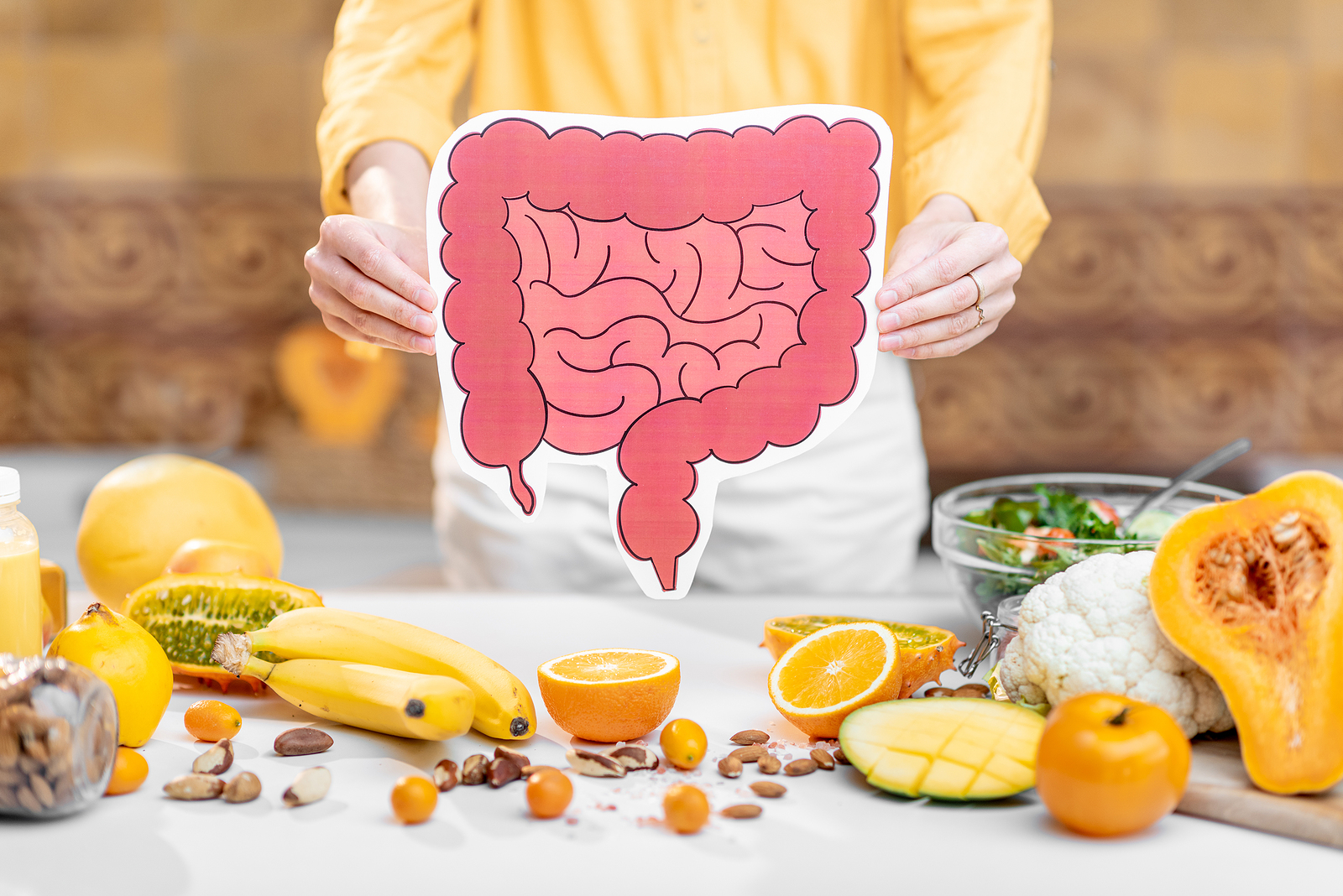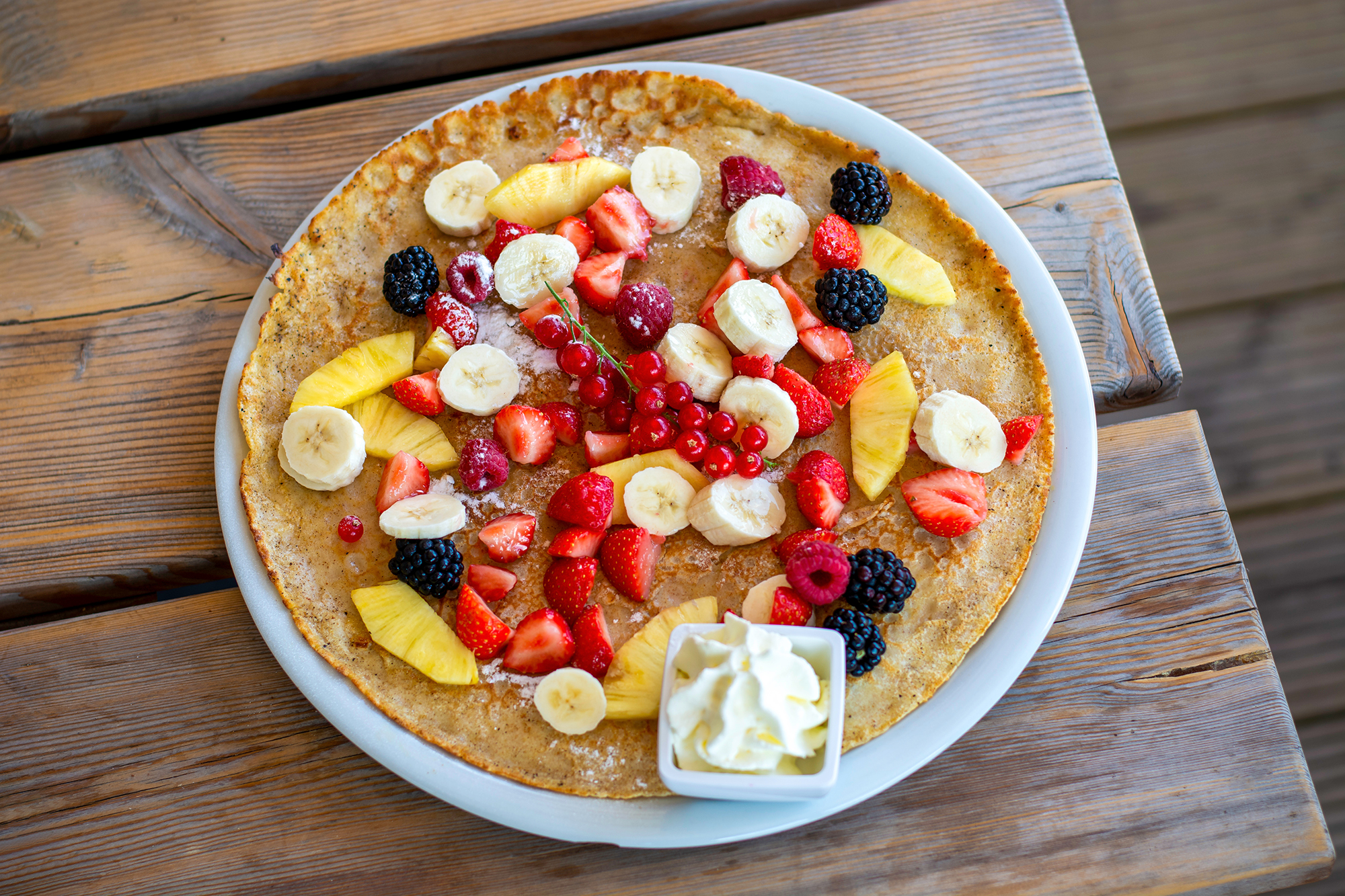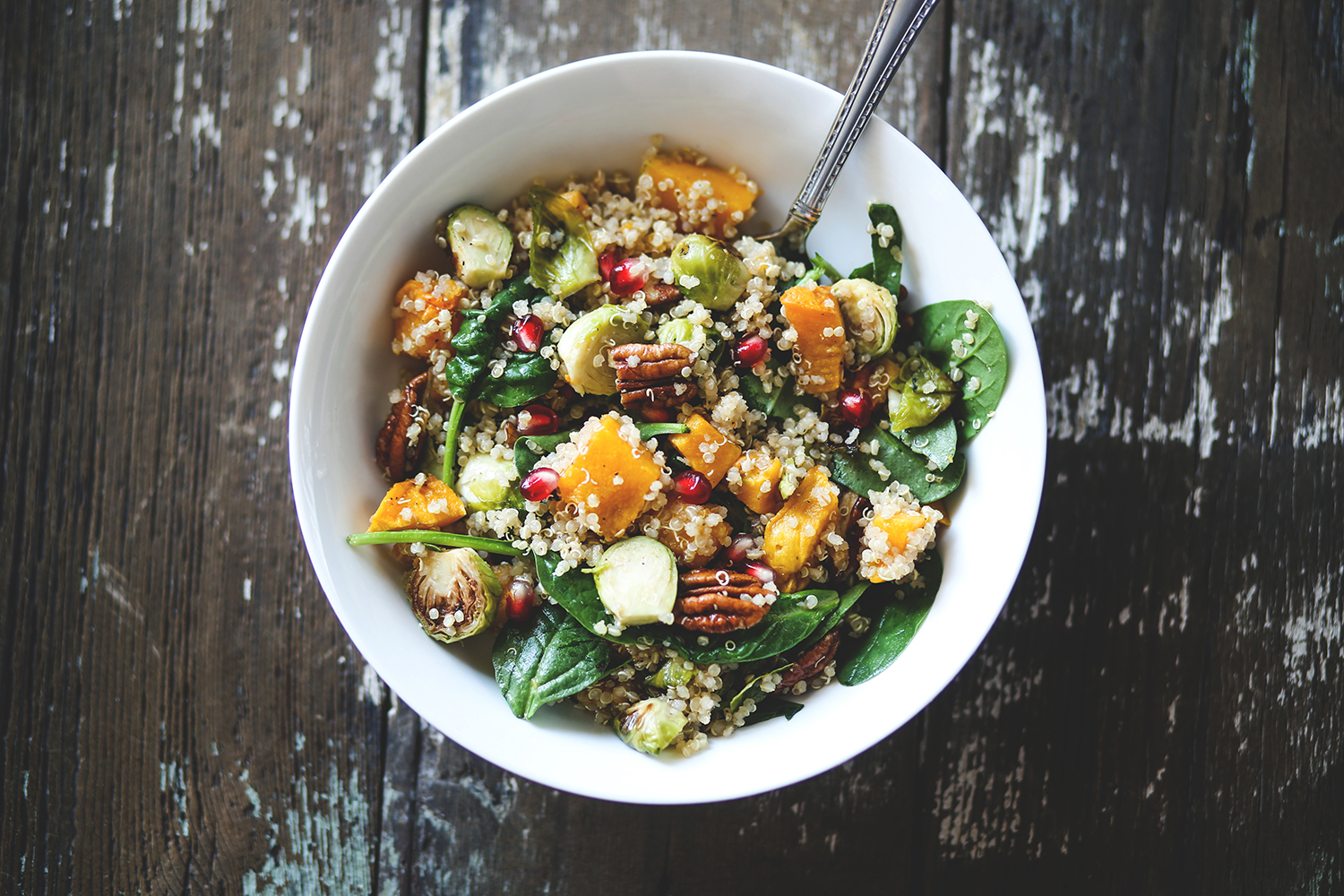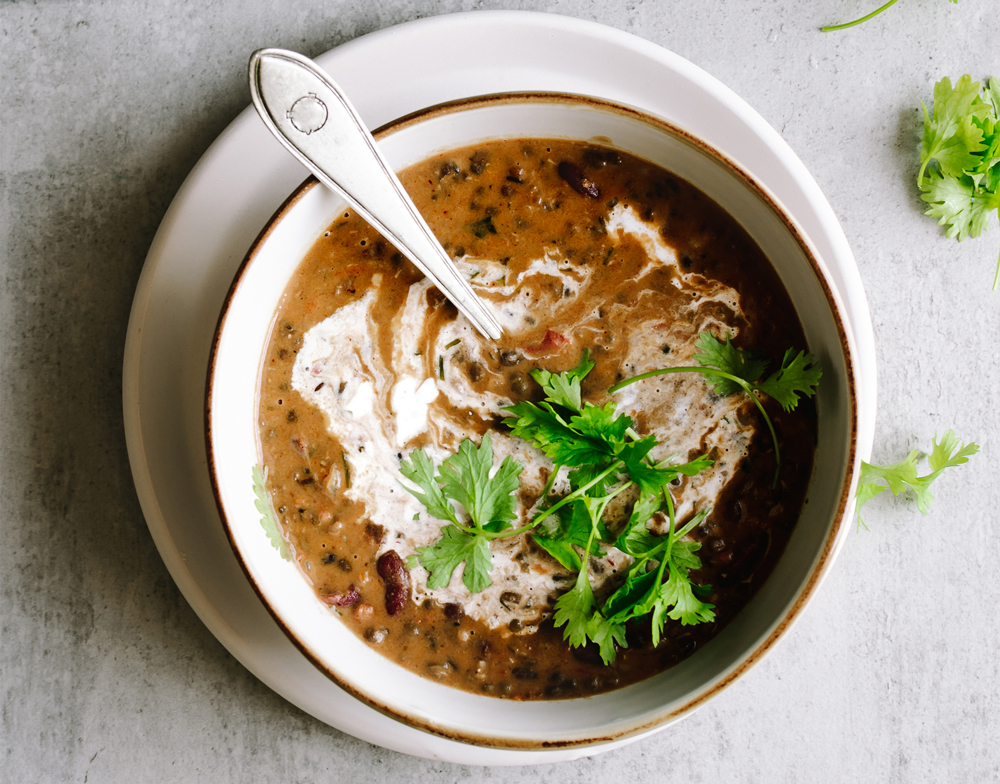 Share on Facebook
Share on Facebook
 According to mindset coach Cara Wheatley-McGrain, who beat her inflammatory bowel disease with a holistic approach, learning how stress impacts your gut is the key to keeping it healthy and happy.
According to mindset coach Cara Wheatley-McGrain, who beat her inflammatory bowel disease with a holistic approach, learning how stress impacts your gut is the key to keeping it healthy and happy.
Have you ever noticed how your appetite is impacted by how you feel? When you are anxious, depressed or stressed, you may overeat or struggle to eat at all. Either way, your digestive system will be off-kilter. A little short-term stress is OK, but when we experience stress in a sustained way, it becomes a problem and impacts the gut in some specific ways.
Your gut and brain are connected by the vagus nerve. Its job is to communicate information straight from your organs (specifically the gut) to the brain, and it’s a bidirectional relationship. If you’ve never heard of the vagus, it’s about time you had an introduction.
This long, wandering nerve starts at the base of your brain below the ears and continues along the side of the throat, the heart and lungs and into the gut. And this is why it’s so fascinating. The vagus nerve is woven into the wall of the intestine. So, what happens in the vagus never just stays in the vagus. It turns out that the vagus plays a key role in supporting our physical and mental health.1
What does that mean for you and your gut? As humans, we live between two key states, with either our sympathetic or parasympathetic nervous system activated.
When we are stressed, the brain triggers the adrenal glands to release the hormones adrenaline and cortisol. These hormones feed a series of responses. Under stress, our sympathetic nervous system is dominant. When we are in stress mode, we are in our flight or fight readiness.
In flight or fight, our bodies divert blood to the muscles and heart, and this reduces the blood supply to the gut. While all this is happening, digestive juices get repressed. We don’t need a hamburger and a side order of fries when we’re getting ready for flight or fight. So less saliva, less gastric juice.
Imagine your ancestors out hunting a big, scary animal. The stress response was a highly efficient and sensible system. It worked well for that kind of sudden, high-risk situation. Big, frightening animal: cortisol floods our system, increasing fat and sugar levels in the bloodstream to feed our muscles ready for action. That’s why, after a bout of stress, you may feel depleted.
Right after a stressful event, you have a strong biological pull to refuel, and thousands of years of evolution mean you’re more likely to head for high fat, easy sugar energy. That cocktail of surging stress hormones acts to shut down digestion (constipation) or speed it up (diarrhea). Take-home message: when we eat in stress mode (rushed lunches, rapid-fire dinners), our gut struggles.
Back to the vagus
The vagus nerve aligns with your parasympathetic nervous system—the rest, reset and digest system. This is the state in which you want to spend more time, especially when you’re eating.
Vagus nerve activation means blood supply returns from the muscles and heart back to the inner organs, ready for digestion. The salivary glands start flowing, heart rate decreases and breathing naturally slows.
Most of us are easy prey to adrenaline—a gut wash of cortisol. Too much traffic, an interview, an argument, and our heart rate goes up. Thanks to heart rate monitors like Fitbit watches, we can actually see this in action. In these moments, our gut shuts down. When we get really clear gut-led knowledge on just how much eating on the go and general levels of stress impact the gut, we can set out to make changes.
Base belly breathing
The breath can ground you deeply into your gut, right into the core of your being. Breathing with awareness reminds us we are embodied: body, heart and gut—all inextricably linked. There are many breathing techniques you can explore that can help stimulate your vagus nerve and link you deeply into your parasympathetic nervous system. Below is a simple, portable little number, which I use daily.
If you are going through an IBD flare right now, this can be a powerful healing agent to calm and support your gut. Spend three minutes doing this practice, then aim to take three breaths at least each hour—you can set a reminder on your phone. The aim is to slowly change the mindless habit of shallow breathing so that you are deeply in your body and belly. Once you’ve got this practice down pat, you can take it anywhere, anytime.
1) Find a quiet space and set a three-minute timer.
2) Sit upright comfortably with your back straight and your shoulders open. Place your dominant hand lightly on your belly, palm flat, and your non-dominant hand on your chest. Now take a deep breath into your lungs and imagine you are breathing deep into your root chakra (right into the base of your bum).
3) You will start to feel your non-dominant hand move outward. As you naturally exhale your breath, imagine you are misting the glass of a mirror with your mouth slightly open. You can even make an ‘ahh’ sound.
4) Breathe in again and repeat. By focusing on drawing in your breath beyond your belly, down into your root chakra, you will naturally find you breathe more deeply. You will feel grounded and present.
Note: If this is the first time you’ve tried abdominal breathing, you may feel blocked. If this is the case, be gentle and take time to practice. If you continue to breathe deeply into your root without forcing it, but calmly and with focus, you will find your energy shifts. This may be accompanied by an emotional shift. If you’ve received messages about it not being OK to cry, you may notice a release in your diaphragm.
Modern life and your gut
Right now, most of us are living a standard Western lifestyle, the kind of 24-7 world our ancient biome has never had to navigate before. Over half of patients who have an inflammatory bowel disease (IBD) flare say it was triggered by stressful life events.
Stress triggers can also be cumulative rather than isolated. Sometimes we can feel stretched thin across the competing demands of our lives, saturated by the sheer amount of stuff that fills our days. So it’s vital to make time for some gut reflection.
Personalizing your gut knowledge
A key part of the jigsaw to managing your gut is creating a space to mindfully tune into inflammation at its subtlest early stages. I have IBD and irritable bowel syndrome (IBS), but I’ve been fortunate to be well and generally symptom-free for 20 years (since my colon’s near-miss with the scalpel). What I have been doing consistently is showing up for my gut in the most loving, mindful and compassionate way I can.
Those familiar with IBD and IBS know how an inflamed gut feels—it generally means pain. But it’s possible to tune into the early signs of inflammation and start to recognize your body’s triggers. These subtle, fluttering levels of discomfort are easy to ignore—and that’s a problem. For me, it starts with a subtle, unsettled feeling. If I ignore it, it moves toward a full, fizzing pain and the problem grows.
To capture those early signs, you need to slow down and use a few simple daily practices like the mindful base belly breathing practice (see page 41). This is not airy-fairy stuff but deep biological processes that happen when you stop and breathe. In fact, it’s all about your vagus nerve. Remember, what happens in the vagus never stays in the vagus.
Healing self-compassion
I’m so excited to see recent studies showing what, at some level, my gut instinct always told me. Self-compassion reduces inflammation in the body.2 This hasn’t been looked at specifically in IBD, but scientists have studied inflammatory markers in the body.
One recent study found that higher levels of compassion, wisdom and social support are linked to a richer, more diverse gut microbiome. The opposite is also true—lower levels of compassion and social connectedness are linked to reduced microbial diversity.
Tanya T. Nguyen, PhD, assistant professor of psychiatry at UC San Diego School of Medicine, said that “the mechanisms that may link loneliness, compassion and wisdom with gut microbial diversity are not known, but observed reduced microbial diversity typically represents worse physical and mental health.”3
When we talk about stress, we think it is ‘all in our head,’ but stress has specific, measurable biological impacts on the body. And it appears to work both ways. Stress increases the likelihood of inflammation and vice versa.4 The next time you’re exasperated or tough on yourself for feeling stressed, remember it’s not just in your head.
Do you want lower blood pressure, improved digestion, less anxiety and greater resilience? Well, think back to what you learned about the vagus nerve, because you may need to aim to increase your vagal tone. Low vagal tone is associated with a range of health problems: stress and anxiety, poor gut health and lack of gut bug diversity.
Too much sitting, poor sleep and an out of sync circadian rhythm, even smoking or excessive alcohol, all appear to be implicated in reduced vagal tone. Happily, there are lots of ways to increase your vagal tone (see box, right).
Crucially, by recognizing the vagus nerve as a key player in your gut–brain alliance you can begin to heal your gut.The three gut-healing recipes included here, all corn-, dairy-, gluten- and yeast-free, are a great place to start.
Gut love
Higher vagal tone increases mental resilience, meaning the body can relax faster after high-stress situations. Some simple ways to get toned include:
Breathwork. A few deep base belly breaths (see page 41) will tone your vagus nerve and shift you into your parasympathetic nervous system (rest and repair setting).
Practice intermittent fasting by having a later breakfast and early dinner so that you give your digestive system a little R&R.
Take probiotics, such as Lactobacillus and Bifidobacterium strains, which have an anti-anxiety effect.1
Do mindfulness and loving-kindness practices, such as breathing exercises (see page 41), as well as journaling and visualization exercises.
Splash your face with cold water. If you are brave, go for a full-blast cold shower. Breathe deeply and relax as you do this.
Have a hug for at least 30 seconds and combine with a few deep breaths. If there’s no one to hug, then try self-soothing by using the havening technique, a simple exercise to put you into a ‘safe space’ and reduce stress. (See www.havening.org for more information and how to do it.)
Do a yoga stretch. Cobra pose is a wonderful way to stimulate the vagus nerve in the neck and deepen vagal stimulation combined with base belly breathing.
Sing, hum or chant out some gut-loving affirmations.
Massage, self-massage or a foot rub from a loved one.
Exercise in all its shapes and forms.
Laughing and socializing (but go easy on the alcohol).
Pancake heaven

These gluten- and dairy-free pancakes can be seasonally updated with your choice of gut-friendly fruit.Berries are an excellent choice as they’re anti-inflammatory and great for your gut. You can use chia/flaxseed to create a ‘chia egg’ (when you combine chia seeds with water to make a gel) to help bind the ingredients, but a banana will also do the trick.
Serves: 3–4
Prep time: 20 minutes
Ingredients
3 oz/100 g flour mix: oat/almond (or buckwheat if you can tolerate it)
1 large green banana
10 fl oz/300 mL coconut milk
½ tsp organic coconut oil
1 Tbsp chia seeds
To serve
A portion-size of pineapple chunks (2¾ oz/80 g), blueberries (2¾ oz/80 g) and raspberries (2¾ oz/80 g)
1 lemon, juice and zest (organic lemons are unwaxed—the best choice for zesting)
A sprinkle of your favorite nuts and seeds
1 dollop of kefir-based yogurt or coconut yogurt per person
2 Tbsp tahini
Directions
1) Blitz the flour, banana and coconut milk before stirring in the chia seeds.
Leave the mixture to stand for 5 minutes to let the chia seeds soften and expand. The mixture should have a batter-like consistency, adding in a little more liquid or flour if needed.
2) Warm a smidgen of coconut oil in a nontoxic frying pan. Cook the pancakes one by one by placing a large tablespoon of pancake mix in the pan at a time (aiming for a disc around 4 in/10 cm). Cook each pancake for a few minutes on each side or until golden brown.
Pile on a warm plate while you finish cooking the rest of the pancakes.
3) Sprinkle each pancake with pumpkin seeds for an omega boost and pack your plate high with your favorite fruit. Serve with yogurt, nut butter or tahini for extra protein.
Warming autumnal salad

This super salad contains 10 plant-based ingredients including sprouts, which pack a punch of gut-healthy goodness.
Serves two as a main or four as a side
Prep time: 1 hour 15 minutes
Ingredients
3 oz/100 g quinoa, cooked
1 lemon, zest and juice
1 large butternut squash, cut into rough chunks
Drizzle of olive oil
4¼ oz/120 g sprouts, thinly sliced (leave these raw, or if that’s not quite to your taste sauté in a hot, dry pan for 2 minutes to soften)
3 oz/100 g mixed dandelion and arugula (rocket) leaves
1 small zucchini, spiralized—fit the straight blade to create ribbons of thin zucchini or swap out for cucumber for a fresher taste
2¾ oz/80 g lightly toasted nuts (walnuts and cashews work well)
Directions
1) Cook the quinoa to the packet instructions.
For zing, add the whole zest and juice of one lemon as it cools.
2) Drizzle the cubed butternut squash with olive oil and place in a preheated oven (390°F/200°C) for 35 minutes.
3) Once cooked, combine the quinoa, roasted butternut squash, sprouts, salad leaves and zucchini. Sprinkle with toasted nuts.
Lentil dhal

This simple staple of Indian cooking is a delicious way of packing more pulses and veggies into your diet. It’s a mild dhal with warming back notes of heat, but you can add more spice if you prefer. You can also swap out the brown rice for quinoa to mix up your grains.
Serves four
Prep time: 40 minutes
Ingredients
1 tsp coconut oil or olive oil
1 large red onion, chopped finely
Large nub of ginger, grated
½ tsp cumin
1 tsp garam masala
½ tsp turmeric
½ tsp mustard seeds
½ tsp ground black pepper
1 tsp coriander seeds, crushed
4 cardamom pods, crushed
½ large chili, deseeded and chopped—keep the white stuff for the highest levels of antioxidants
7 oz/200 g dry lentils, rinsed
14 oz/400 g organic plum tomatoes, canned
14 oz/400 g coconut milk for an extra creamy note, optional
18 fl oz/500 mL filtered boiled water
7 oz/200 g of your choice: spinach or Swiss chard
Stir in the juice of a fresh lemon at the end to lift and enhance the flavors
To serve
200 g/7 oz brown rice (high-fiber, nutty taste), cooked to package instructions
A generous handful of fresh cilantro or coriander to dress
2–3 Tbsp cucumber raita (mix together 200 mL/7 fl oz of dairy-free yogurt (coconut or plain) with 6 in (15 cm) of cucumber, finely chopped
A sprinkle of fennel seeds
1 Tbsp (homemade) pickled mango chutney, optional
Directions
1) Cook the brown rice to the package instructions, usually around 25 minutes.
While the rice is cooking, add the onions and the smallest amount of oil to a pan over medium heat. Once the onions are softened, add in your spices.
2) As they start to release their flavors, stir with a wooden spoon and add the lentils and hot water with the tomatoes.
3) Once the mixture has come to a slow simmer, reduce the heat and cover for 18 minutes, stirring occasionally.
4) Stir in the coconut milk (optional) and simmer for a further 5 minutes.
5) Add the spinach or chard and cover the pan for 2–3 minutes until the leaves are soft and wilted. Serve the dhal on top of the rice, and sprinkle with fennel seeds.
6) Serve with cucumber raita and a spoonful of chutney.
Top tipS
• Kale and chard have more texture than spinach, so you might want to cut out the harder stems. All pack a superfood punch of phytonutrients.
• Red onions have higher levels of polyphenols than white or brown varieties.
Main Article
https://www.wddty.com/features/learn-how-stress-impacts-your-gut/?utm_medium=email&utm_source=wddty&utm_content=How+stress+impacts+your+gut+health+&utm_campaign=FREE+MEMBERS+enews+-+%28How+stress+impacts+your+gut+health%29+02.09.2021
|
References |
|
|
1 |
Front Neurosci, 2018; 12: 49 |
|
2 |
Brain Behav Immun, 2014; 37: 109–14 |
|
3 |
Front Psychiatry, 2021; 12: 648475 |
|
4 |
Jacka, F. Brain Changer: How Diet Can Save Your Mental Health. Yellow Kite, 2019. p107. |
Gut love
|
References |
|
|
1 |
Front Psychiatry, 2018; 9: 669 |




